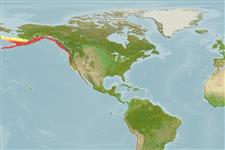Common names from other countries
Environment: milieu / climate zone / depth range / distribution range
Ecologie
marien demersaal; diepte 1 - 325 m (Ref. 6793). Temperate; 64°N - 33°N, 179°W - 118°W
Eastern and Western Pacific: The Bering Sea coast of Alaska, near the Aleutian Islands (Ref. 27436) to the West Bering Sea and to Redondo Beach, southern California, USA.
Grootte / Gewicht / Leeftijd
Maturity: Lm ? range ? - ? cm
Max length : 63.0 cm TL mannelijk / geslacht onbekend; (Ref. 2850)
Korte beschrijving
Determinatiesleutels | Morfologie | Morfometrie
Dorsale stekels (totaal) : 0; Dorsale zachte stralen (totaal) : 72 - 88; Anale stekels: 0; Anale zachte stralen: 53 - 66; Wervels: 37 - 39. Dorsal origin above point in front of eye. Caudal rounded. Pectorals small.
Inhabits sandy bottoms. Feeds on fishes, worms, crustaceans and mollusks (Ref. 6885).
Vinnikov, K.A., R.C. Thomson and T.A. Munroe, 2018. Revised classification of the righteye flounders (Teleostei: Pleuronectidae) based on multilocus phylogeny with complete taxon sampling. Molecular phylogenetics and evolution, 125:147-162. (Ref. 122998)
Status op de Rode Lijst van het IUCN (Ref. 130435)
CITES (Ref. 128078)
Not Evaluated
Gevaar voor de mens
Harmless
Gebruik door de mens
Visserij: commercieel; sportvis: ja; Aquarium: Publieke aquaria
Tools
Speciale rapporten
Download XML
Internetbronnen
Estimates based on models
Preferred temperature (Ref.
115969): 1.3 - 8.7, mean 5.2 (based on 314 cells).
Fylogenetische diversiteitsindex (Ref.
82804): PD
50 = 1.0000 [Uniqueness, from 0.5 = low to 2.0 = high].
Bayesian length-weight: a=0.00912 (0.00457 - 0.01819), b=3.10 (2.93 - 3.27), in cm Total Length, based on LWR estimates for this (Sub)family-body shape (Ref.
93245).
Trofisch niveau (Ref.
69278): 4.1 ±0.67 se; based on food items.
Weerstandsvermogen (Ref.
120179): Gemiddeld, minimale populatieverdubbelingstijd 1,4-4,4 jaar (tm=2).
Fishing Vulnerability (Ref.
59153): Moderate to high vulnerability (45 of 100).
Climate Vulnerability (Ref.
125649): High vulnerability (62 of 100).
